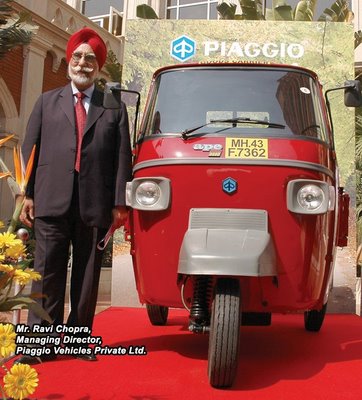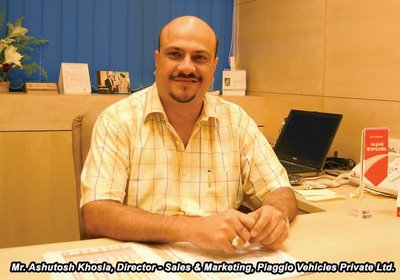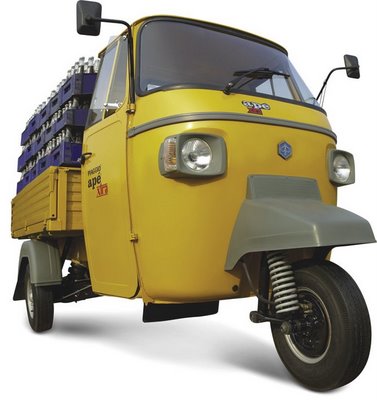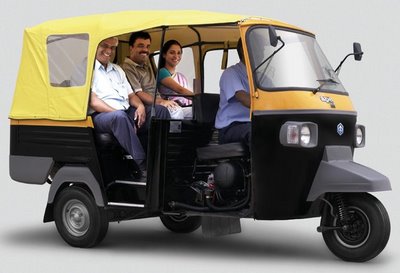 – K. Gopalakrishnan
– K. Gopalakrishnan
Recently I was driving down the National highway from Chennai to Bangalore. The new four-lane highway cuts across some important towns like Ranipet, Vellore, Krishnagiri and Hosur. Much to my surprise, I could see that 8 out of the 10 three-wheelers (both cargo and passenger) on road were from Piaggio. Quite undoubtedly, Piaggio has established its market leadership in a segment which was for decades dominated by Bajaj Auto.
In fact, when Piaggio entered the Indian market in 1998, the sustainability of its project was doubled by most players in the Indian automobile industry. However, in 1999 the company sold 2,000 units, and it ended the year 2007 with sales of 1,59,000 units.
Today, Piaggio has emerged as the market leader in the three-wheeler segment out-beating the so far undisputed market leader Bajaj Auto in the domestic market. In the first five months of the calendar year 2008 Piaggio has sold 62,236 vehicles compared to 55,108 vehicles sold by Bajaj Auto in the domestic market.
Behind the success of Piaggio is a dedicated team led by Mr. Ravi Chopra, Managing Director, Piaggio Vehicles Private Ltd. (PVPL). In a lot of ways Mr. Chopra has been the face of Piaggio in India right from day one and after years of hard work and commitment, its a great feeling for him to see the company emerge as the market leader in the segment.
“I am proud to say that Piaggio is No.1 in the total three-wheeler segment in the domestic market. We are ahead of everybody both in the passenger and goods segments”, says Mr. Ravi Chopra.
Driven mainly by the local management, today the company is seeing its vision unfold into a reality. Its remarkable growth and achievements today are the result of the total commitment, dedication and hard work of a “winning team”.
In 2007 Piaggio sold a total of 159,000 units comprising 85,000 passenger carriers, 65,000 goods vehicles, 4,000 Ape Truks and 5,000 CNG/LPG-powered passenger and goods carriers. The company logged a positive growth when the industry as a whole registered a negative growth last year. Piaggio has always been the leader in the cargo segment, and in recent months the company has strengthened its position in the passenger segment as well. In 2008 Piaggio is targeting eight per cent growth in three-wheeler sales. It is currently hitting volumes of about 13,000 units per month. “We have been growing in a falling market. The industry has seen a slowdown not because of the market needs or potential but more because of the reluctance of the financing agencies to support retail financing. That has now come to a very critical situation. In 2008, particularly in the last 2 to 3 months the situation has become more stressful for the industry. The financing companies are selective in financing and have not been as generous and liberal as they have been in the past. Their expectations of higher down payments, and higher EMIs has certainly impacted the growth”, adds Mr. Chopra.
“We have been growing in a falling market. The industry has seen a slowdown not because of the market needs or potential but more because of the reluctance of the financing agencies to support retail financing. That has now come to a very critical situation. In 2008, particularly in the last 2 to 3 months the situation has become more stressful for the industry. The financing companies are selective in financing and have not been as generous and liberal as they have been in the past. Their expectations of higher down payments, and higher EMIs has certainly impacted the growth”, adds Mr. Chopra.
Piaggio’s success story in India is a typical case example of how a global company can effectively use its global processes in a local environment by customizing its product and fine-tuning its business model to suit the Indian market. The company’s growth and performance reflects a creditable and empowered local management, which has effectively evolved its business model on the basis of three principles: commitment at the global level, empowered local level management and localised product / market mix.
Till 2002 the company was selling just under 40,000 units per annum, far behind the market leader Bajaj Auto. Since then, Piaggio has more than tripled its sales volumes, from 49,600 vehicles in 2003 to more than 159,000 vehicles sold in 2007. The man who has spearheaded much of this transformation is Mr. Ashutosh Khosla, Director – Sales & Marketing of Piaggio Vehicles Private Ltd.
One should admit that selling a three-wheeler is not like selling any other automobile. The customer who buys a three-wheeler is usually an owner operator and the vehicle is his lively hood. So unless he is capable of making money out of the vehicle, he will not be in a position to repay his monthly dues.
Mr. Khosla says: “First we sell a business proposition to our customer and then our three wheeler. As a pioneer in the business we have always believed in creating new markets and segments. In Piaggio we say that you need to identify a customer, understand his needs and capability and sell an appropriate solution which he will be able to sustain”.
He cites key reasons for the success of Piaggio in India, the first being the company’s focus on offering a superior quality product. In 1998 when the company entered India, it found that the cargo segment was a neglected segment. It was inadequate in terms of technologies and product variants. Piaggio can take much of the credit for creating the cargo segment. The second important reason is that the company understood the way the business should be done.
“The approach at Piaggio is very clear. We believe in selling a business proposition first to our customer, and this approach of ours has created trust and a strong long-term relationship with customers. The customer believes in our brand and our dedicated approach has helped us in generating further reference from our satisfied customers. Thirdly, Piaggio understand that the vehicle is a breadwinner for its customer and thus the responsibility lies with company to provide a truly world class customer care. These are the key reasons for the growth of Piaggio in India. We are here to build and nurture life long partnerships with our customers”, says Mr. Khosla.
Piaggio Vehicles began with the realisation that with improving road infrastructure, the country was moving towards a hub-and-spoke mode of conveying goods. This meant that heavier trucks would do the inter-city movement of goods while the intra-city, the last-mile connectivity through narrow, inner-city roads would require smaller, more manoeuvrable vehicles. That was its chosen slot, of moving goods on congested roads using its sub-1 tonne three-wheeler. Piaggio already has more than 6,00,000 satisfied Ape customers in India today.
Piaggio has pioneered the three-wheeler goods transportation in India and has achieved and sustained a leadership status in the cargo segment and today it has emerged a leader both in passenger and cargo segments as well. Piaggio is now recognized not just as a leader in its class, but has also set standards in fuel efficiency, load carrying capacity and lowest operating costs.
Piaggio’s current product range includes half-tonner cargo vehicles (pick-up and delivery van), and 3-seater passenger vehicles in various fuel variants like diesel, CNG and LPG, and sub-one ton four-wheeler Ape truk.
The three-wheeler segment has been witnessing robust growth in the last few years with domestic volumes crossing 400,000 units in 2006-07. But the year 2007-08 has not been very encouraging for the market. The industry witnessed a decline of almost 10 per cent last year as it sold 364,000 units.
Mr. Khosla says he is not worried about the slowdown. “The demand for three-wheelers is still very strong in the market. B
ut owing to due to lack of financial support we are witnessing a significant drop in retail sales”.
Easy to manufacture, tough to sell
A three-wheeler is probably the most easiest to manufacture and the most difficult to sell. But identifying an opportunity in this segment many new players have entered the segment and in the process have flooded the market with vehicles due to availability of cheap finance in the previous years.
Some of the manufacturers oversold their products to certain customers who didn’t have the capacity to repay their dues and in the process it has impacted the confidence of the financiers on a segment of customers who don’t have banking habits.
But one important fact that needs to be mentioned here is that these customers are more reliable and dependable and definitely have the genuine intentions of repaying their dues.
Mr. R. Sridhar, Managing Director, Shriram Transport Finance Company Ltd., says: “These customers have better intentions of paying back their dues”.
In fact, some of the vehicle finance companies like Shriram Transport Finance and IndusInd Bank have mastered the art of financing the three-wheeler segment and have perfect understanding of the customers. Seeing this, even banks like ICICI are creating a rural vertical to tap the untapped potential.
Three-wheeler segment
When Tata Ace was launched a couple of years back, the general feeling was that the three-wheeler segment would vanish over a period of time. It did have an impact on the on the bigger three wheelers which are the 0.75 tonner vehicles.
Mr. Khosla observes: “There is no replacement for a three-wheeler. The cost per tonne km on a three-wheeler is much lower when compared to the cost per tonne of a four-wheeled truck. The initial enthusiasm of owning a four-wheeler pushed sales in this segment but very soon customers will check their pockets and in certain segments there could be a realisation that the three-wheeler made more economic sense than a four-wheeled truck. I strongly feel that the game has just begun”.
In 2007 Piaggio sold close 1,60,000 units and for 2008 the company is planning to grow by 8% in an industry which is already facing a negative 9% growth. There is no dearth of potential, says Mr. Khosla. The three-wheeler segment in China is 3 times the size of the Indian market because there are more motarable roads in China. Three-wheelers can be driven even in deep rural and countryside markets in China, which is not possible in India in absence of good rural road infrastructure. Now since there is a heavy thrust in rural road infrastructure development we see future growth coming from rural markets.
Mr. Khosla further observes: “In India, the three wheeler cargo segment is a ten-year-old story in a 60 year old economy. We strongly believe that opportunity of growth exists and three-wheeler industry is going to build numbers going forward”.
Ape Truk
In mid-2007 Piaggio launched Ape Truck, a four-wheeled mini-truck, to take on competition from the Tata Ace. The company has launched the product in most part of the country. Currently it is selling approx. 800 units every month and the company plans to double the volumes in the next few months. “We will surely be able to replicate the success of our three wheelers in the four-wheelers as well. Our strength is our network. Currently the Ape Truck is sold from 180 out of our 671 dealer network points, which is roughly 35% of our network reach. This offers huge potential for future growth once we make the product available our dealer network point”, adds Mr. Khosla.
It is a challenge to find the appropriate customer for the four-wheeler. We are educating our front line people to identify customers who are most appropriate for the four-wheeler segment, adds Mr. Khosla. At the end of the day, in the commercial vehicle industry, we believe that facts are going to rule the game. In a long run the product has to clearly make money for the customer.
Currently there is a very narrow gap, in terms of carry capacity, between the three wheelers and the entry level four-wheeled mini trucks available in the market. But once the sub one-tonner four-wheeler segment moves to the next level, which could be sub two-tonner, there will be a clear differentiation in the market and this could result in volume growth.
Sales and service
Piaggio has created a truly world class organisation in India with supporting infrastructure in terms of sales and service. Mr. Khosla says that, “Piaggio has the highest post warranty ratio which is the best across all automobiles manufacturers in the country”. Last year the company invested a lot on promoting service activities. Including the Ape Maha Utsav, which generated references through existing satisfied customers.
Piaggio has established a network of 670 sales and service outlets across India. The company has established a pan India network from Baramula in the North to Nagerkoil in the South and from Bikaner in the West to Imphal in the East.
Piaggio has always laid emphasis on service. The company follows a scorecard system that is called the DEECORE system wherein each dealership is audited for efficiency, quality and reach. This system was started last year and the results have been very encouraging, says Mr. Khosla.
In fact, Piaggio has significantly improved its market share in markets like Bihar, Jharkhand, Rajasthan, Madhya Pradesh, North East and Karnataka.
Investment in engines
Globally, Piaggio as a group has announced plans to invest In India quite aggressively. The group plans to invest 60-65 million euros in the development and industrialization of twin-cylinder turbodiesel and diesel engines (upto 1,200 cc) and construction of a powertrain plant in Baramati. Daihatsu will partner the group on development and industrialization of the new powertrains.
The group, through its Indian subsidiary, has also signed an 8-year agreement with Greaves Cotton Ltd. under which Greaves will continue to supply PVPL with the GL 400 BSII monocylinder diesel engine and will also supply PVPL with the G 435 BSIII monocylinder diesel engine, beginning 2010 to coincide with the pan-Indian introduction of the Bharat III emissions regulations in India.
Greaves will provide Piaggio with the engines, as the sole supplier of monocylinder diesel engines for Ape three-wheelers, thus enabling the Piaggio Group to meet its objectives for eco-compatibility, efficient fuel consumption and general product price competitiveness.
In addition to the supply agreement with Greaves, the Piaggio Group has a close partnership with Kohler (earlier Lombardini), which supplies Piaggio with the 482cc liquid-cooled 5-speed diesel engine mounted on the Ape Truk four-wheeler.
The rapid industrialization and growth in the Indian economy and the resulting need for logistics management has driven Piag
gio’s growth in the country. Going forward, transportation of men and material will continue to improve, given the growth targets of the Indian economy. The need will further get enhanced with the development of the rural sector. Given this growth potential the company envisages a growth of 15 per cent per annum for itself over the next five years.
The goods transportation sector in India is also witnessing a major shift in focus and is developing into a “hub and spoke” model. Whilst multiple axle, tractor-trailer large size vehicles are today dominating inter city transportation system, smaller three-wheeler and light commercial vehicles are catering to the movement of goods within a city. This shift in focus is expected to generate a large requirement for the smaller commercial vehicles, including the three-wheeler.
Piaggio has also begun to export its Ape vehicles from India to many countries including Argentina, Peru, Sudan, Sri Lanka, Mexico, South Africa, Cuba and Bangladesh. Till recently PVPL’s focus was on catering to the increasing domestic market needs in India. However it now has aggressive plans for a major thrust on the export front in the coming years. The company expects 10-15 per cent contribution to its turnover from exports in the future years.